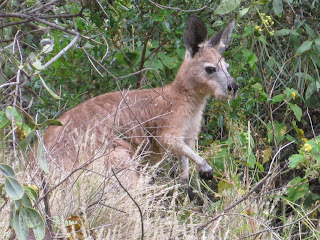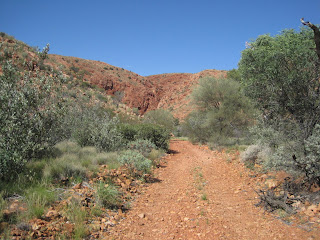November 28, 2010
Today is Sunday, the first day of Advent, my favourite time of year. The birds flutter and croon and the cool wind brushes against my fleece jacket as I sing Lauds in the bush a short distance from camp.
There are a few notable natural sites between Yulara and Alice Springs , but the main tourists attractions are roadhouses. The three we stop at are privately run by the stations whose land they sit on. The cattle stations in the central outback are huge – Curtin Springs is 1.27 million acres – and have a rich, if somewhat controversial history of their own. Since I began reading Richard Trudgen’s Why Warriors Lie Down and Die, a history of early white settlement in North Arnhem Land, written from the Yolnu Aborigines’ perspective, I’ve felt wary about the popular lore offered up by the media of the rugged, swashbuckling Aussie battlers who staked their claims in this inhospitable land in the late 19th and early 20th centuries. Their arrogance and ignorance of Aboriginal settlements and cultures often resulted in escalated tensions and physical violence (from both sides). With the white man’s superior weaponry and prevailing attitudes, which saw ‘natives’ as merely part of the flora and fauna and therefore dispensable, the Aborigines suffered many massacres and huge trauma.
Curtin Springs has been run by the Severin family for several generations and their history is on display at the roadhouse. Photos, signage, banners, memorabilia and lots of classic Aussie outback humour line the walls of the tavern, where a stocky old blue heeler lounges on the cool floor, glaring up at any visitors who pass through the door. A young woman tends the bar and shuffles off to the back room when she hears that we’re not interested in buying anything.
Curtin Springs Roadhouse
Mt Ebenezer Roadhouse is the only Aboriginal owned station in the Northern Territory
The Erldunda and Stuarts Well roadhouses boast the world’s largest echidna and the world’s only singing dingo, respectively. Indeed the echidna ran about four meters long and two meters high – shades of Disneyland . We didn’t see the singing dingo; perhaps he was asleep? Each station has its own unique expression of the station owner’s history and their peculiar quirks and characteristics. Despite what the guidebook stated, neither were particularly friendly towards tourists.
Our destination for the night is Alice Springs, but at the last minute we decide to take a 27kms detour east on a dirt road that leads to the Rainbow Valley Conservation Reserve 66 kms south of Alice. A geologist’s heaven, the craggy multi-hued rocks are remnants of a 500 million year history of erosion. The reserve was deeded back to the local Arrernte Aborigines and the circle of interpretative panels offers two explanations for the site: the western scientific view and the aboriginal spiritual ‘dreaming’ view. The Arrernte call this place Wurre, an important sacred site that “identifies where we came from, and who we are”. I’m particularly struck by a comment at the end of the panel: “When we look at the land, it’s part of us, not just a pretty site”.
A short walk trail leads to Mushroom Rock, which only looks like its namesake from an odd angle at the back. As I walk the track I feel the conflict between my western bred value system and my desire to explore and understand the Aboriginal way. At the rock, a sign asks walkers to turn around and return the way they came; the traditional owners don’t want tourists clambering around on the site. I feel very restricted by this – my nature is to clamber and explore – and quietly disregard the request as I follow a well-trammeled path up the back of the cliffs. The view is stupendous. I sit for a while and take it in. I want to clamber up further, but my conscience gets the better of me and I opt for returning the way I came.
View from the top
We select one of the sites in the simple camp area, which has a beautiful view of the rock face. A traditional low-lying square table used by Aborigines in their social gatherings is constructed at each site. We decide to pull out our bed from the camper trailer and sleep under the stars. The evenings have become cool, requiring use of the doona, but it still takes us a while to get warm when we climb in bed after sundown. My love of star-gazing is whetted by a magnificent meteorite shooting horizontal across the sky with a splendid shimmering tail.
Sunset view
Johan doing his usual Mr Fix-It thing (one of our gadgets died...)
Campin' under the stars

















































